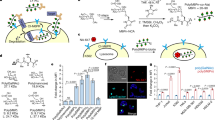Abstract
BHK cells transfected with human cathepsin D (CD) cDNA normally segregate the autologous hamster cathepsin D while secreting a large proportion of the human proenzyme. In the present work, we have utilized these transfectants to examine to what extent the mannose-6-phosphate-dependent pathway for lysosomal enzyme segregation contributes to the differential sorting of human and hamster CD. We report that, in recipient control BHK cells, the rate of mannose-6-phosphate-dependent endocytosis of human procathepsin D secreted by transfected BHK cells is lower than that of hamster procathepsin D and much lower than that of human arylsulphatase A. The missorted human enzyme bears phosphorylated oligosaccharides and most of its phosphate residues are “uncovered”, like the autologous enzyme. Thus, despite both the Golgi-associated modifications of oligosaccharides, i.e. the phosphorylation of mannose and the uncovering of mannose-6-phosphate residues, which proceed on human and hamster procathepsin D with comparable efficiency, only the latter is accurately packaged into lysosomes. Ammonium chloride partially affects the lysosomal targeting of cathepsin D in control BHK cells, whereas in transfected cells, this drug strongly inhibits the maturation of human procathepsin D and slightly enhances its secretion. These data indicate that: (1) over-expression of a lysosomal protein does not saturate the Golgi-associated reactions leading to the synthesis of mannose-6-phosphate; (2) a portion of cathepsin D is targeted independently of mannose-6-phosphate receptors in the transfected BHK cells; and (3) whichever mechanism for lysosomal delivery of autologous procathepsin D is involved, this is not saturated by the high rate of expression of human cathepsin D.
Similar content being viewed by others
Author information
Authors and Affiliations
Additional information
Received: 24 July 1997 / Accepted: 11 November 1997
Rights and permissions
About this article
Cite this article
Isidoro, C., Baccino, F. & Hasilik, A. Human and hamster procathepsin D, although equally tagged with mannose-6-phosphate, are differentially targeted to lysosomes in transfected BHK cells. Cell Tissue Res 292, 303–310 (1998). https://doi.org/10.1007/s004410051061
Issue Date:
DOI: https://doi.org/10.1007/s004410051061




